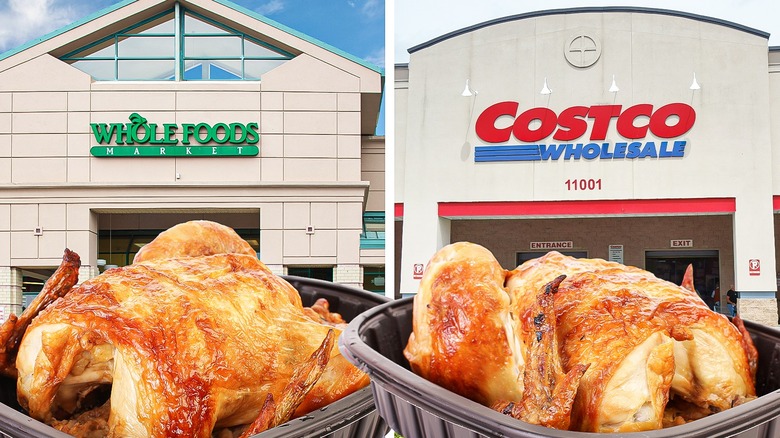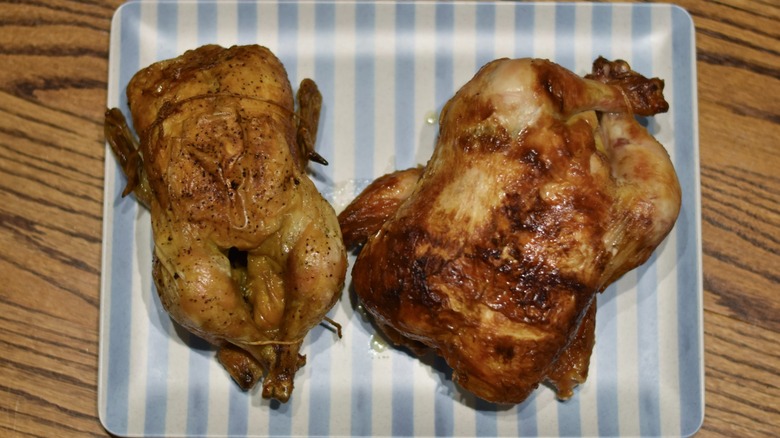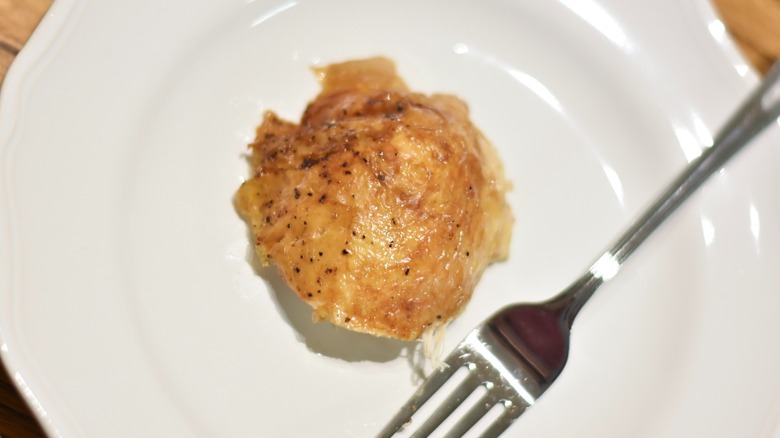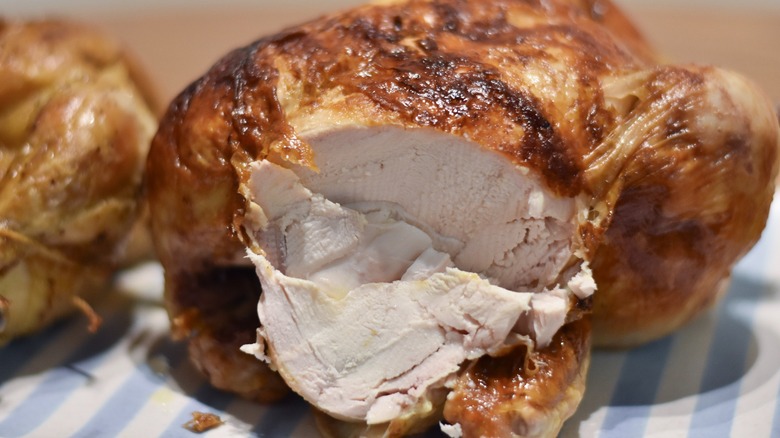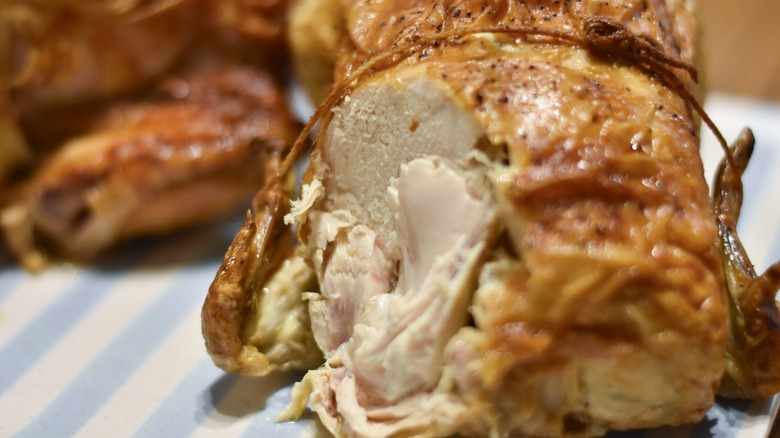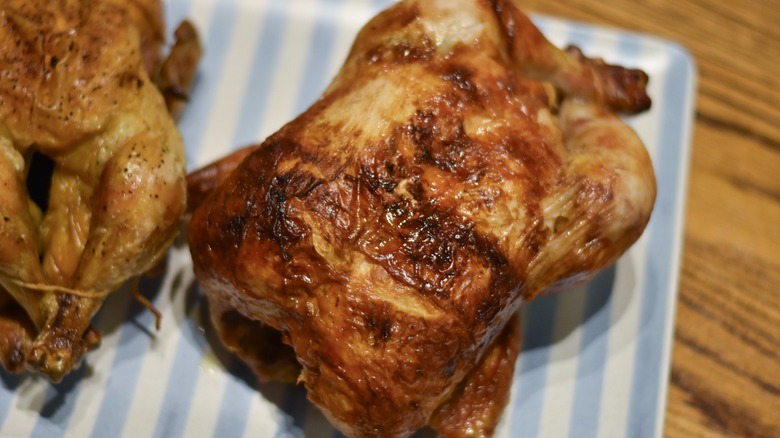Costco Vs Whole Foods: Who Makes The Best Rotisserie Chicken?
Costco and Whole Foods are known for their high-quality offerings. Costco offers more budget-friendly items sold in bulk, and Whole Foods caters to those interested in natural and organic foods.
Both chains have very dedicated customer groups and almost cult-like followings for some of their most popular products. This is especially true for prepared foods, many of which are customer favorites. Rotisserie chicken is one of Costco's consistent top sellers, but walk by the Whole Foods deli section and your mouth will water at the sight and smell of similar birds there. Both stores offer delicious rotisserie chicken, but which one is the best?
To see how they compare, we tried the classic rotisserie chicken from Whole Foods, one of a few varieties the store offers, and picked up one of the seasoned rotisserie chickens from Costco. When looking closely at both birds, we considered the skin and the meat, giving both a thorough taste test on their own and as part of a chicken salad and chicken quesadillas, two of our go-to ways to use leftover rotisserie chicken. Because ready-made chicken is one of our favorite items for a budget-friendly and easy meal, we also looked at price, size, and availability to see which won the top prize.
Price comparison
With its reputation for budget-friendly bulk purchases, it wasn't a surprise that Costco's chicken was both cheaper and larger than Whole Foods' chicken. The Whole Foods bird is around one pound and costs approximately $9 and the organic option is available for $4 more. The Costco chicken is a whopping three pounds and costs just $4.99. That's so budget-friendly that when we first began buying rotisserie chicken years ago, we thought the price must be a typo or a special promotion. The chicken is still the same jaw-dropping price it was back then, which is one of the reasons that many Costco shoppers go out of their way to get these at the store.
You can get a two-pack of whole raw chicken at Costco to roast at home yourself, but at more than $20, each chicken is double the cost of the rotisserie chicken. At Whole Foods, a whole raw chicken is around $3 per pound so if you do decide to roast it yourself, it would end up a bit cheaper if you found a bird roughly the same size as the rotisserie chicken.
How can Costco keep the chicken priced so low? The store relies on this item to get customers in the door, counting on additional impulse buys once they're wandering the aisles. Costco strategically keeps the chicken at the very back of the store so that everyone in search of it has to walk by plenty of other products and promotions. You may go in for a $4.99 rotisserie chicken but you'll likely come out with hundreds of dollars worth of additional Costco products.
Nutrition info
Chicken is a great source of lean protein, which is why it's such a regular staple in our home's recipe lineup. With 22-23 grams per serving, Whole Foods' rotisserie chicken has more protein than the Costco version, which has 19 grams of protein.
Costco's and Whole Foods' rotisserie chicken also each have a serving size of three ounces, but the Costco version has fewer calories. Costco's chicken is 140 calories with 460 milligrams of sodium, mostly from the salt used in the seasoning blend. The Whole Foods chicken is 190 calories for the same serving size and has 420 milligrams of sodium in the classic style. If you want less sodium, go with plain rotisserie chicken, which has only 70 milligrams of sodium because it doesn't have any exterior seasoning applied before roasting.
Kirkland Signature seasoned rotisserie chicken
Costco's rotisserie chicken had a noticeably dark golden brown exterior. The skin was very flavorful thanks to the cooking process and seasoning. The bird had a lot of white and dark meat, which were both moist and delicious. Once we got past the larger chunks of breast and thigh meat, it was a bit harder to pick every bit off the slightly dryer ribs and wings. But considering that we already had a lot of chicken, this wasn't a big deal. In the past, we've used the bones to make broth and were happy to have extra meat to give it a boost in flavor.
We thought that maybe this chicken included coloring agents to get the richly colored skin or possibly MSG for savoriness, but it is made without either. Each rotisserie chicken is only kept on the shelf for two hours before the team brings it to the back to repurpose it for other deli items. This ensures that every chicken you purchase at Costco is at its freshest.
Whole Foods classic rotisserie chicken
Whole Foods chickens are raised without antibiotics, which is important if you want to avoid the potential impacts of poultry pumped full of medicine. The rotisserie chicken comes in four varieties: classic with salt and pepper, organic classic, organic plain, and lemon herb. This chicken was noticeably smaller than the Costco bird, but still full of flavor both inside and out. The taste of the meat was practically identical and if we didn't know that we were sampling two different chickens, we'd likely not notice any difference.
The skin was lighter but had larger pieces of cracked pepper that gave it a little more flavor than the Costco bird. It was crispy but a little tough in some places and chewy in others. We ended up cutting most of the skin off before serving the chicken. For dishes that include pulled chicken as an ingredient, such as matzo ball soup or chicken fajitas, this textural difference in the skin wouldn't have much of an impact. The meat was juicy, especially the white meat, which tends to get a little bit dry. We picked up the chicken right when it was being put out on the shelf, which meant we had a really fresh bird.
The best rotisserie chicken
Both Whole Foods and Costco rotisserie chickens are high-quality and with flavorful, juicy meat. But Costco outshines Whole Foods when it comes to the chicken skin, not to mention the price and size. When the chicken tastes better overall, is three times as large, and is still cheaper, it's hard to think of a reason to choose anything else. There's enough chicken to enjoy for an easy weeknight dinner and have leftovers to make a tasty chicken pot pie later.
The only catch with this chicken is that you have to have a Costco membership to purchase it, so factor in that additional cost when you're making your shopping list. If you're already a Costco member or plan to get other items at the bulk warehouse retailer, adding a bird to your cart is a no-brainer. But if you have to shell out an extra $65 for an annual membership just for a rotisserie chicken, it suddenly gets much more pricey.
Whole Foods does have the advantage in terms of the selection of rotisserie chicken it offers. There are organic options as well as some with more and less seasoning, while Costco just has the standard seasoned variety. If you want a little extra peppery flavor, for example, go with Whole Foods. This is perfect for chicken chili or other dishes where you want that extra kick. Otherwise, the difference in taste is so minimal that it won't change your dish in the end.
